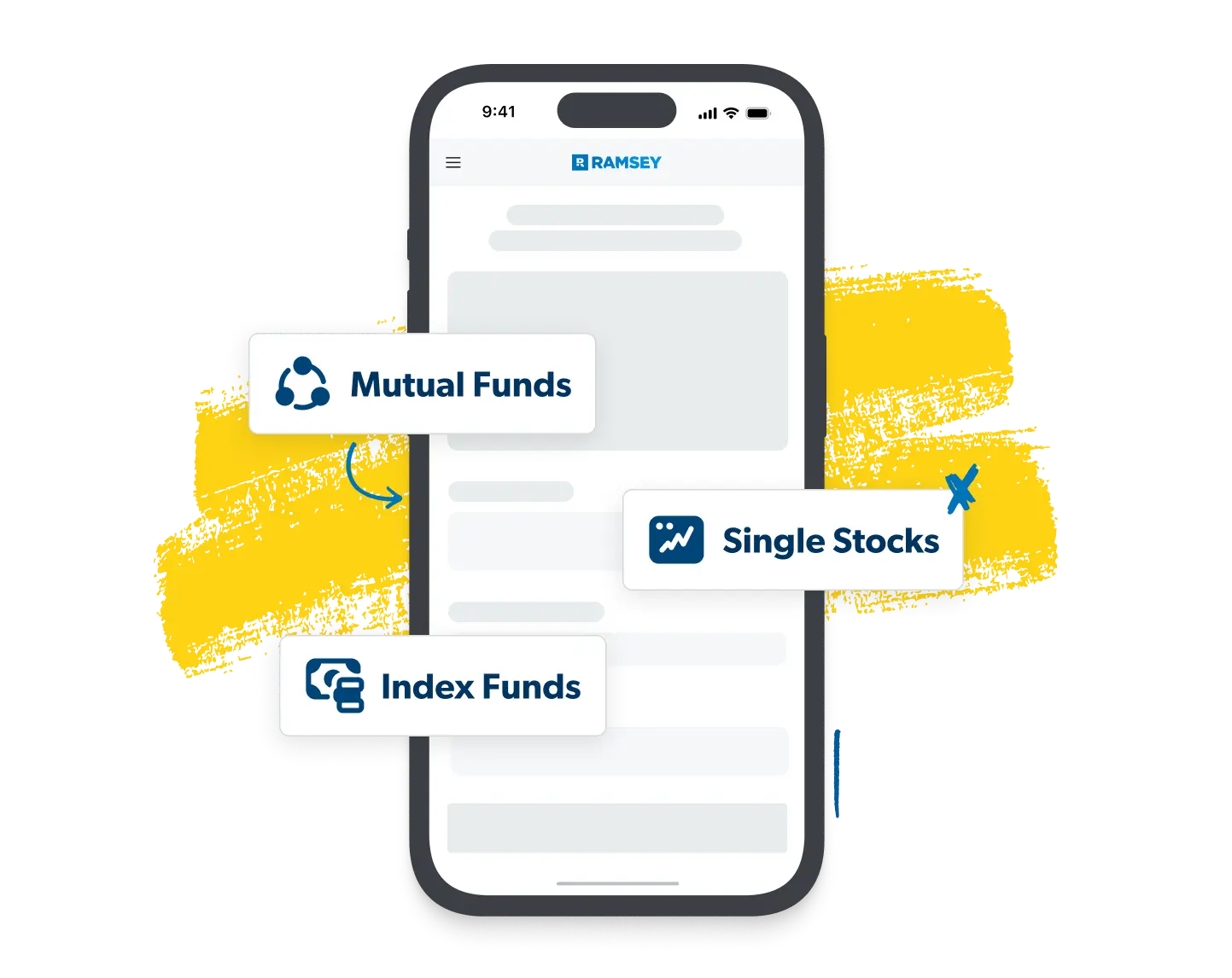
Investment Calculator
Want a sneak peek at how much your investments could be worth in the future? Just plug in a few numbers.

A little money consistently invested grows into a lot of money. Get the knowledge and resources you need to make your money work harder for you.
Ramsey’s Complete Guide to Investing breaks down everything from investing fundamentals to advanced strategies—all in plain, jargon-free English.

Set yourself up for success with resources for every stage of your journey.
Ramsey Solutions is a paid, non-client promoter of participating pros.
Find out more about how investing can help you achieve your financial goals.
We get it. Investing can be intimidating, especially when you’re new to it all. The good news is that anyone can become an investor—yep, even you. Let’s start with the basics.


Take a deep dive into stocks, bonds, mutual funds and other types of investments. Discover how each works, their pros and cons . . . and which one we recommend.
While we always recommend investing for retirement first, you don’t have to stop there. Explore college savings funds like 529 plans, or find out if real estate investing is right for you.

SmartVestor™ is an advertising and referral service for investment professionals operated by The Lampo Group, LLC d/b/a Ramsey Solutions (“Ramsey Solutions”). When you provide your contact information through the SmartVestor site, Ramsey Solutions will introduce you to up to five (5) investment professionals (“Pros”) that cover your geographic area. Each Pro has entered into an agreement with Ramsey Solutions under which the Pro pays Ramsey Solutions a combination of fees, including a flat monthly membership fee and a flat monthly territory fee to advertise the Pro’s services through SmartVestor and to receive client referrals from interested consumers who are located in the Pro’s geographic area. Each Pro may also, if applicable, pay Ramsey Solutions a one-time training fee.
The fees paid by the Pros to Ramsey Solutions are paid irrespective of whether you become a client of a Pro and are not passed along to you. However, you should understand that all of the Pros that are available through SmartVestor pay Ramsey Solutions fees to participate in the program. Further, the amount of compensation each Pro pays to Ramsey Solutions will vary based on certain factors, including whether the Pros choose to advertise in local or national markets. Ramsey Solutions has a financial incentive to present certain Pros that offer their services on a national basis (“National Pros”) more often than other National Pros that pay lower fees.
It is up to you to interview each Pro and decide whether you want to hire them. If you decide to hire a Pro, you will enter into an agreement directly with that Pro to provide you with investment services. Ramsey Solutions is not affiliated with the Pros and neither Ramsey Solutions nor any of its representatives are authorized to provide investment advice on behalf of a Pro or to act for or bind a Pro. Ramsey Solutions introduces you to Pros that cover your geographic area based on your zip code. Neither Ramsey Solutions nor its affiliates provide investment advice or recommendations as to the selection or retention of any Pro, nor does Ramsey Solutions evaluate whether any particular Pro is appropriate for you based on your investment objectives, financial situation, investment needs or other individual circumstances.
No investment advisory agreement with a Pro will become effective until accepted by that Pro. Ramsey Solutions does not warrant any services of any SmartVestor Pro and makes no claim or promise of any result or success by retaining a Pro. Your use of SmartVestor, including the decision to retain the services of a Pro, is at your sole discretion and risk. Any services rendered by a Pro are solely that of the Pro. The contact links provided connect to third-party websites. Ramsey Solutions and its affiliates are not responsible for the accuracy or reliability of any information contained on third-party websites. Each Pro has signed a Code of Conduct under which they have agreed to certain general investment principles, such as eliminating debt and investing for the longer-term, and, if applicable, have completed Ramsey Pro Training. However, Ramsey Solutions does not monitor or control the investment services the Pros provide.


Let’s face it—investing has a lingo all its own. Here’s a cheat sheet that breaks down different terms you might encounter as you read through our investing content.
Assets:
An asset is something you own that has monetary value. Stocks, mutual funds, ETFs, bonds, etc., are often referred to as financial assets.
Annuity:
An annuity is a contract you make with an insurance company. You make a payment (or payments) and they agree to provide you with a guaranteed income for life.
Bonds:
A bond is a loan you give to a corporation or government agency for a set amount of time. In return, they pay you back with interest.
Certificates of Deposit (CDs):
CDs are kind of like a savings account that you agree not to withdraw from for a set amount of time. In exchange, they typically offer slightly higher interest rates than the average savings account.
Cryptocurrency:
Cryptocurrency is digital money that exists solely in a computer network. You exchange real money to buy “coins” or “tokens” that aren’t tied to a bank or government.
Exchange-Traded Funds (ETFs):
ETFs are very similar to mutual funds because they allow you to invest in a portfolio of assets. The main difference is that they can be traded throughout the day like stocks.
Money Market Funds:
A money market fund is a type of mutual fund that invests in super short-term, low-risk debt securities.
Mutual Funds:
Mutual funds collect money from a large group of investors and invest it in a collection of assets. Think of it like investing in a professionally managed portfolio.
Real Estate Investment Trusts (REITs):
REITs (pronounced “reets”) are similar to mutual funds, only they invest in income-producing real estate instead of stocks.
Stocks:
Stocks, also known as shares or equities, stocks are small pieces of ownership in a company.
Asset Allocation:
Asset allocation describes the way your investments are divided between different types of assets (like mutual funds, bonds and cash).
Bear Market:
A bear market is when the stock market’s overall value is declining, usually by at least 20% from a recent high.
Bull Market:
A bull market is when the value of the overall stock market is rising or expected to rise.
Capital Gains:
Capital gains are simply profits from assets you sell.
Capital Gains Tax:
Taxes you pay on the profit from an investment you sell.
Diversification:
Diversification is the strategy of spreading out your money into different types of investments. It’s basically the art of not putting all your eggs in one basket.
Dividends:
Some companies share their profits with their stakeholders in the form of payments called dividends.
Index Fund:
An index fund is a kind of mutual fund that mimics the performance of a market index, like the S&P 500.
Liquidity:
Liquidity measures how easy it is to access your money or sell an asset and turn it into cash. For example, money in a savings account is very liquid, while real estate is a less liquid investment.
Market Capitalization (Market Cap):
Market capitalization, or “market cap,” basically means the total value of a company’s stock.
Market Index:
A market index is like a report card for a certain set of stocks. For example, the S&P 500 index measures the performance of the top 500 American companies on the stock market.
Volatility:
Volatility measures the unpredictability of an investment’s price swings over time.
Aggressive Growth (Small Cap) Funds:
Aggressive growth funds, or small cap funds, invest in companies with a market cap between $300 million and $2 billion. They offer the most potential growth but are also the riskiest.
Balanced Funds:
Balanced funds invest in a mixture of stocks and bonds.
Bond Funds:
Bond funds invest in (yep) bonds. While among the least risky investments, they also offer very little growth.
Growth (Mid Cap) Funds:
Growth funds, or mid-cap funds, invest in companies with a market cap between $2 billion and $10 billion. They offer more potential growth but a bit more risk than large cap funds.
Growth and Income (Large Cap) Funds:
Growth and income funds, or large-cap funds, invest in shares of companies with a market cap of $10 billion or more. They tend to offer slow and steady growth.
Income Funds:
Income funds invest in stocks that pay regular dividends.
International Funds:
International funds invest in companies outside the U.S. (like LG, Mercedes and BMW).
Sector Funds:
Sector funds invest in stocks within a particular sector of the economy like technology, health care or energy.
Stock Funds:
Stock funds, also called equity funds, are made up of (you guessed it) stocks.
Target Date Funds:
A target date fund is an investment fund that gradually shifts your investments from high-risk, high-reward assets to low-risk, low-reward assets as you near retirement.
Actively Managed:
Actively managed funds are those run by a fund manager who attempts to beat the performance of a certain sector of the market.
Passively Managed:
Passively managed funds just try to replicate the returns of a certain sector of the market.
Front-End Load:
A front-end load is a one-time commission or fee that’s deducted from an investment when you buy it.
Back-End Load:
A back-end load is a fee that’s deducted from an investment when you sell it.
Level-Load:
Level-load funds charge an annual fee each year that you hold the fund.
No-Load:
No-load funds don’t charge any commission to buy, own or sell.